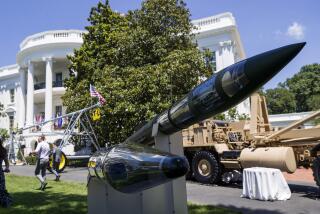AF Resumes Rocket Flights, Launches Titan
WASHINGTON â Ending a 10-month suspension of Titan launches, the Defense Department has boosted a classified payload into orbit from Vandenberg Air Force Base in what Air Force Secretary Edwin C. Aldridge on Thursday called âthe first major step in the recoveryâ of the Pentagonâs crippled space program.
The launching of a Titan 3B at 10:40 p.m. Wednesday placed the payload into polar orbit about 100 nautical miles above the Earth, an Air Force spokesman said. He said that the payload was in the â7,000-pound classâ but would not give other details, citing national security.
While details of Wednesday nightâs launch were withheld, the Pentagonâs ability to put payloads into space is critical to the operation and maintenance of intelligence-gathering and communications satellites that play a central role in monitoring the Soviet Union and other nations for arms control and other national security purposes.
With the Titan program halted and the space shuttles grounded in the wake of the 1986 Challenger accident, serious questions had been raised about the countryâs ability to maintain vital satellite operations.
The Titan program was halted last April when a Titan 34D exploded shortly after launching, destroying the rocket and damaging the Vandenberg launching facilities in California. Eight months earlier, in August, 1985, another Titan 34D was destroyed in a launching failure.
The Titan 3B--the rocket launched Wednesday night--is a large, two-stage, liquid-fueled booster. By strapping large solid-fuel boosters onto the 3B, the rocket is transformed into the more powerful 34D.
In a statement accompanying the Air Forceâs announcement of Wednesday nightâs launching, Aldridge said that the success âgives the country confidence that we have regained assured access to the critically important space environment to support our national security interests.â
The grounding of the Titans and the shutdown of the space shuttle program after the Challenger disaster a year ago have combined to cause a backlog in the launching of military payloads and cargoes.
By early next year, one Pentagon source estimated, âwe will have 23 payloads backed up on the pads.â
That backlog could be eased when the Air Force next year begins launching the first of 13 Titan 2s, the former intercontinental ballistic missiles that the Air Force is converting into space launching vehicles.
Launch Decision Due
While the Titan 3B launched Wednesday night was the last booster of that type still in the Air Force inventory--67 others were launched over the last two decades--the service has on hand six of the more powerful 34Dâs. A decision is expected late this month on whether to launch one of these from Vandenberg in May or June, Pentagon sources said.
With the Wednesday launching, an Air Force spokesman said, âwe have confidence again in what we did to recoverâ from the August, 1985, failure, which was traced to a massive oxidizer leak and pump malfunction in the core booster. âIt showed we have solved that problem,â he added.
Work is still under way to identify and correct potential problems in the solid rocket boosters identified as the cause of the explosion last April, the spokesman said. The rocket launched Wednesday did not have the solid rocket boosters attached.
Faulty Joint Blamed
A faulty joint in a solid rocket booster was blamed for last yearâs explosion of the shuttle Challenger, which killed the seven crew members and brought the nationâs space exploration program to a halt.
Since then, the National Aeronautics and Space Administration has redesigned the booster and is conducting extensive tests, aiming for a resumption of shuttle launches in February, 1988.
More to Read
Sign up for Essential California
The most important California stories and recommendations in your inbox every morning.
You may occasionally receive promotional content from the Los Angeles Times.










